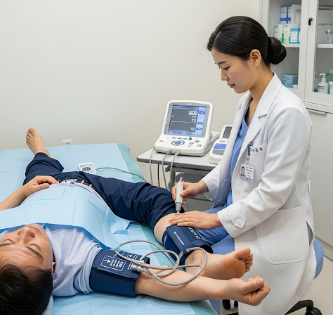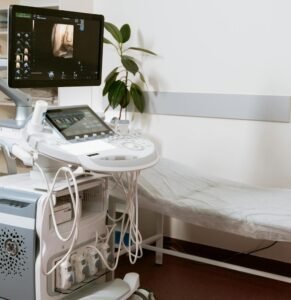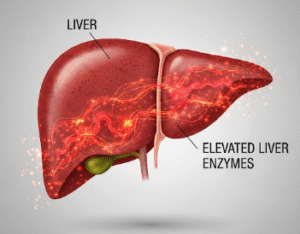Overview
The Ankle-Brachial Index (ABI) is a non-invasive diagnostic test used to evaluate blood flow in the lower extremities. It compares blood pressure in the ankle with blood pressure in the arm to detect peripheral artery disease (PAD) or other circulatory problems.
In Korea, the ABI test is widely performed in vascular clinics and cardiology departments using state-of-the-art Doppler ultrasound devices. It is a quick, safe, and reliable tool to assess the risk of leg ischemia, cardiovascular disease, and complications related to poor circulation.
What is Ankle-Brachial Index?
The ABI measures the ratio of systolic blood pressure at the ankle to that at the arm.
How it works:
- Blood pressure is measured in both arms and both ankles using a blood pressure cuff and Doppler probe
- The highest ankle pressure is divided by the highest arm pressure to calculate the ABI
- The result is interpreted as:
- 1.0–1.4: Normal blood flow
- 0.91–0.99: Borderline
- 0.41–0.90: Mild to moderate PAD
- ≤0.40: Severe PAD
Key points:
- Quick, painless, and non-invasive
- Detects early stages of peripheral artery disease before symptoms appear
- Helps guide treatment decisions and lifestyle modifications
- Can also indicate overall cardiovascular health
What are the benefits?
- ✅ Early detection of peripheral artery disease
- ✅ Assesses risk for heart attack and stroke
- ✅ Helps monitor disease progression or treatment effectiveness
- ✅ Non-invasive, quick, and painless
- ✅ In Korea, advanced Doppler devices provide accurate, reproducible measurements
- ✅ Supports preventive strategies and intervention planning
Procedure Details
1) How should I prepare for Ankle-Brachial Index?
- ➤ Wear loose clothing to allow access to arms and legs
- ➤ Avoid smoking, caffeine, or vigorous exercise 30 minutes before the test
- ➤ Inform the technician about medications or cardiovascular conditions
- ➤ Relax and lie down for a few minutes before measurement to ensure accurate readings
2) What happens during the procedure Ankle-Brachial Index?
- ✅ Patient lies flat on an examination table
- ✅ Blood pressure cuffs are placed on both arms and both ankles
- ✅ Doppler ultrasound probe is used to detect arterial blood flow
- ✅ Systolic pressures are measured at each site
- ✅ ABI calculated by dividing ankle pressure by arm pressure
- ✅ Duration: Usually 10–15 minutes, painless and simple
3) What happens after Ankle-Brachial Index?
- ➤ Results are immediately available and explained by the clinician
- ➤ May lead to further testing if PAD or abnormal results are detected
- ➤ Guides treatment options, including lifestyle changes, medications, or surgical interventions
- ➤ Regular monitoring may be recommended for patients at risk of cardiovascular disease
Risks / Benefits
Potential Risks:
- ➤ Minimal; procedure is non-invasive and low-risk
- ➤ Rare discomfort from cuff inflation
- ➤ In very rare cases, skin irritation from the cuff may occur
Benefits:
- ✅ Safe, quick, and effective screening tool
- ✅ Detects PAD early before serious complications arise
- ✅ Helps guide treatment, prevention, and follow-up care
- ✅ Supports overall cardiovascular risk assessment
Recovery and Outlook
- Hospital stay: Outpatient; no hospitalization needed
- Activity: Resume normal activities immediately
- Follow-up: Recommended for patients with borderline or abnormal results
- Outcome: Early detection allows timely interventions, reducing risk of leg ischemia, amputation, heart attack, or stroke
- Patient education: Emphasis on smoking cessation, exercise, diet, and medication adherence
When To Call the Doctor
- ➤ Symptoms such as leg pain, cramping, or numbness
- ➤ Non-healing wounds or skin color changes in legs or feet
- ➤ Persistent swelling or cold extremities
- ➤ Any sudden change in circulation or mobility
Best Korea Option / Process
- ✅ Korea provides advanced vascular clinics and hospitals for ABI testing
- ✅ Uses modern Doppler ultrasound devices for precise and reproducible results
- ✅ Experienced vascular specialists interpret ABI in the context of overall cardiovascular risk
- ✅ International patients benefit from VIP services, English-speaking staff, and coordinated care
- ✅ ABI testing is part of comprehensive vascular evaluation and preventive care programs













